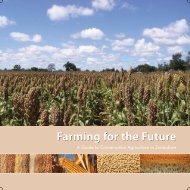Restoring the Soil - Canadian Foodgrains Bank
Restoring the Soil - Canadian Foodgrains Bank
Restoring the Soil - Canadian Foodgrains Bank
Create successful ePaper yourself
Turn your PDF publications into a flip-book with our unique Google optimized e-Paper software.
Decision Tree Guide47it on top of <strong>the</strong> soil (toge<strong>the</strong>r with <strong>the</strong> residues of crops such as maize or millet),so <strong>the</strong> decomposition process will take place more slowly. Leaving <strong>the</strong> mucunavegetation on <strong>the</strong> surface is far preferable in nearly all instances especially sincethis practice also saves labor. A fair amount of nitrogen will be lost into <strong>the</strong> air(it will “volatilize”), but this is normally not a major worry. Smallholder farmersrarely need more than 100 kg N/ha each year.In <strong>the</strong> case of any of <strong>the</strong> maize/mucuna systems, if farmers also raise pigs, <strong>the</strong>ycan experiment with using <strong>the</strong> mucuna to feed <strong>the</strong>m. Mix one part of maize flourwith one part of ground mucuna seeds, <strong>the</strong>n lightly cook <strong>the</strong> dough to make avery cheap (and <strong>the</strong>refore profitable) feed for pigs that is just as nutritious as commercialfeeds. See S8.In rare cases, mucuna is not effective. For example, in Kalimantan Island inIndonesia, <strong>the</strong> local weeds will outgrow <strong>the</strong> mucuna. But this is rare. Ano<strong>the</strong>rsituation is in areas where <strong>the</strong>re are lots of wild animals, such as deer (Kalimantan)or wild grazing animals (near <strong>the</strong> Sierra de Las Minas in Guatemala) whichcan eat enough of <strong>the</strong> mucuna to kill it.ICRAF, <strong>the</strong> World Agroforestry Center, recommends planting trees as improvedfallows. This requires a good deal more labor than just broadcasting mucuna orjackbeans, and it may be several years before you see <strong>the</strong> desired impact on fertilityor weed control. Never<strong>the</strong>less, if <strong>the</strong> area’s natural fallows are quite long andfirewood can be sold at a good price, this would be an option worth considering.Gliricidia and leucaena would be among <strong>the</strong> best species.Pigeon pea was mentioned as ano<strong>the</strong>r appropriate species for improved fallowswhere animals are kept away from <strong>the</strong> fields. A description of pigeon peas can befound in #26.Once you have tried and chosen any one or several of <strong>the</strong>se fallow systems, go to#5.33. Noxious weeds? Is your area relatively free of nut-grass (Cyperus rotundus) andimperata grass (Imperata cylindrica)? If so, go to #35. If not, go to #34.34. There are serious weed problems. Use S59 or S89, and <strong>the</strong>n go to #5.35. Do farmers grow grain legumes? Are any grain legumes widely consumed? If so,go to #36. If not, go to #41.36. Local grain legumes. What grain legumes are locally known and consumed, orhave a good price in local markets, with major demand?a) Lablab beans. Go to #37.b) Cowpeas (Vigna unguiculata), rice beans (V. umbellata) or mungbeans(V. radiata). Go to #38.
















